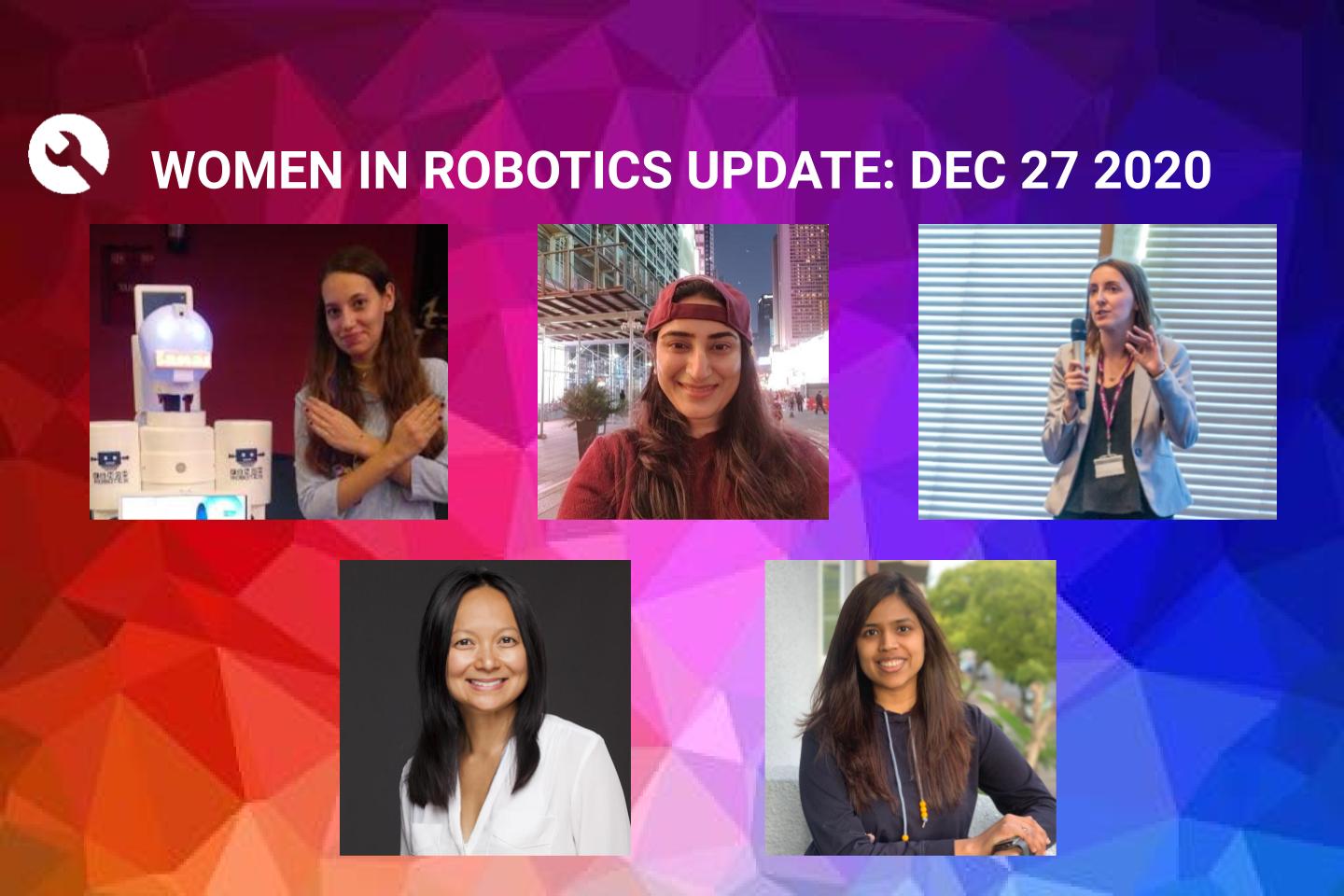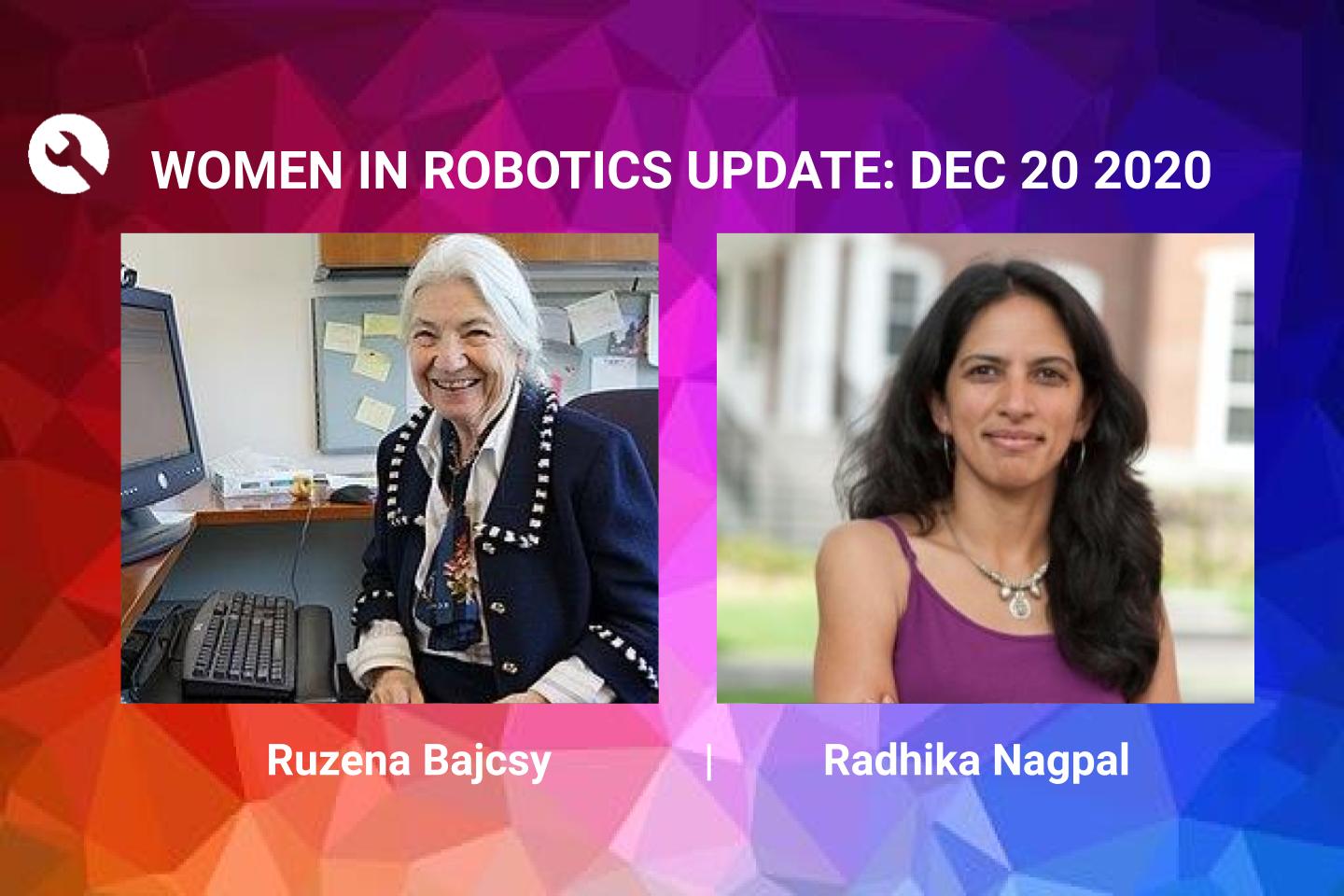Readers Choice 2020: Smarter Robotics Are Changing Security
Readers Choice 2020: Preparing to be Acquired: COVID-19 Has Inspired Small Manufacturers to Embrace Robotics
Women in Robotics Update: Ecem Tuglan, Tuong Anh Ens, Sravanthi Kanchi, Kajal Gada, Dimitra Gkatzia
Welcome to the first of our Women in Robotics Spotlights, where we share stories from women who haven’t yet been featured in our Annual Showcase but who are working on all sorts of interesting projects. We hope these stories provide inspiration to everyone to join us working in the field of robotics. And if you’re a woman working in robotics, why not contribute your story too!
“Making robots communicate with humans in natural language is a fascinating challenge. There is a lot going on during interactions between robots and humans. Humans make gestures, observe or interact with visible objects in the environment, and display emotions. What motivates me is equipping social robots with the ability to interact seamlessly, by recognizing a given situation and talking about it” says Dimitra Gkatzia who specializes in Natural Language Generation for Human-Robot Interaction.
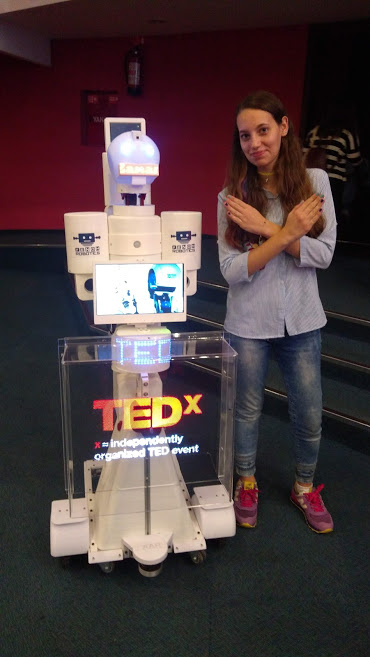 |
Ecem Tuglan
The Mecademi of Team Think Tank | Cofounder of Fenom Robotics
Ecem Tuglan is a The Mecademi of Team Think Tank and Cofounder of Fenom Robotics who is active Robopsychologist working on Philosophy of Artificial Intelligence, Neurophilosophy, Human-Robot interaction, Biopolitics, Robopsychology, Cognitive Sciences and Political Theory. At Fenom Robotics, she and her team builds holograms displaying humanoid robots. She is also working on projects with Dr. Ravi Margasahayam from NASA as a robopsychologist. Tuglan says her interest in robots started during her childhood when she prefered robotic toys and electronic gadgets and this childhood obsession turned more professional when she started studying philosophy. And still, she is always intrigued by how from micro scale to macro scale, everything is changing with robotics and how cell-like robots can save us from various diseases while AI based astrobots can find new home-planets. She enjoys the width of the research in robotics and its interdisciplinary knowledge enhancing our creativity and productivity because we are able to combine anything in our mind to this field. |
 |
Tuong Anh Ens
CEO and Founder at Go West Robotics
Tuong Anh Ens is CEO and founder of Go West Robotics which is a robotics software consulting Company. Exposed to many exciting robotics projects and having very good connections in the robotics community, she decided to focus on helping robotics companies succeed. Her main objective here was to reduce hurdles that occur for so many creative and revolutionizing ideas to take shape and get implemented. Thus, at Go West Robotics, she and her team work with the world’s leading robotics companies to build better automation systems and robots. Ens enjoys the challenges with the future in robotics, ever-changing unknown and our ability to push beyond the boundaries of what was previously inconceivable. Going through the hurdles of both the personal and professional life balance herself, she strongly believes in hardwork and perseverance and believes in her team at Go West Robotics for the accomplishments and growth in robotics. |
 |
Sravanthi Kanchi
Data Engineer at Bayer Crop Science | The Founding Member of The Founders Vault
Sravanthi Kanchi is a data engineer at Bayer Crop Science and the founding member of the Founders Vault. She loves learning, building and researching about building robots and she is currently working to build the home cleaning robot. She enjoys the ideas coming into life in robotics. She aspires to make an impact into people’s lives by building something useful for mankind as she believes in robotics contribution in transformation of healthcare , ergonomics, space, industrial sectors etc. |
 |
Kajal Gada
Content creator at Youtube
Kajal Gada is a robotics software engineer and youtuber. She has 3 years of professional experience. At her last job at Brain Corp, she helped support Brain OS – a software for autonomous mobile vehicles. Her interest in robotics was sparked by a video of drones doing flips autonomously by her mentor who continuously encouraged her to explore robotics. Gada started working on robotics on her own starting with creating her own robot for simple projects such as a line follower and obstacle avoidance and then further enhanced her knowledge in the area with Masters in Robotics from University of Maryland. As the way of giving back to the robotics community she creates and posts tutorials in her youtube channel for free open source software webots to create projects that are beginner friendly, and thus making it easy for anyone to get started with robotics. She has been interviewing existing women in robotics in her youtube channel as well and wants to continue it to inspire younger women and set an example of how someone looking like you started it and did it. |
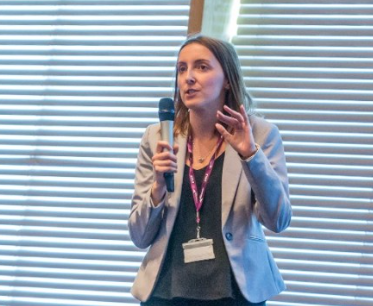 |
Dimitra Gkatzia
Associate Professor at Edinburgh Napier University
Dimitra Gkatzia is an associate professor at School of Computing at Edinburgh Napier University where she leads a UK-funded project in robotics, CiViL. CiViL aims to provide robots with human-like abilities, such as reasoning and communicating using commonsense. She is also a co-founder of the workshop series NLG4HRI, which aims to bring together researchers interested in developing NLG methods for Human-Robot Interaction. Gkatzia’s expertise is in Natural Language Generation (NLG), i.e. teaching computers “how to talk”, Data-to-text generation, AI, Machine Learning, summarization of time-series data. With her proficiency in this field she is dedicated to making dialogue systems (such as Alexa, Siri) converse naturally, by enhancing their responses with commonsense and world knowledge. She entertains the far-ranging scope and the endless possibilities for robotic applications. “Robotics has shown promising results in assistive technology, education, and health”, says Gkatzia who envisions a future where humans and robots coexist and collaborate in domestic, public and work settings and robots used to solve real-world problems. |
And we encourage #womeninrobotics and women who’d like to work in robotics to join our professional network at http://womeninrobotics.org
James Bruton focus series #3: Virtual Reality combat with a real robot
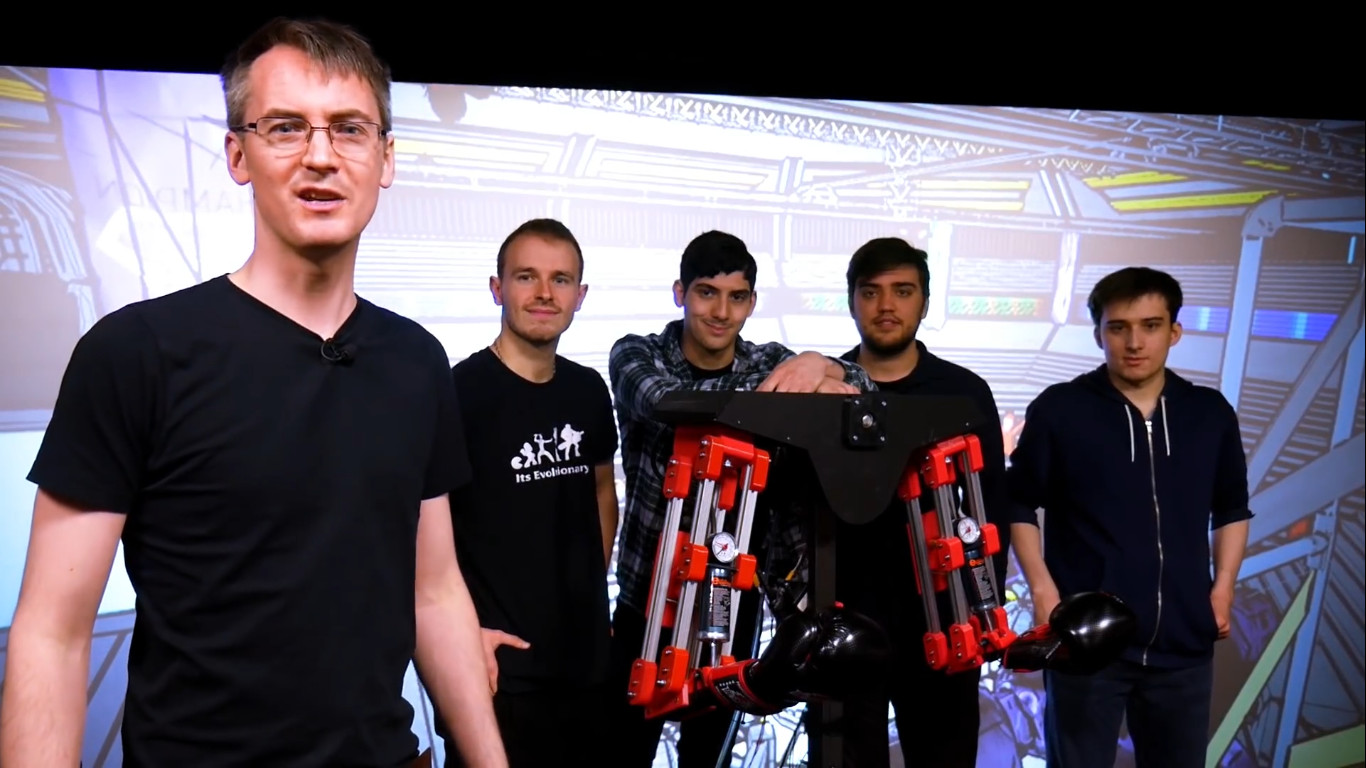
It’s Saturday, it’s the turn of another post of the James Bruton focus series, and it’s Boxing Day in the UK and most of the Commonwealth countries. Even if this holiday has nothing to do with boxing, I didn’t want to miss the opportunity to take it literally and bring you a project in which James teamed up with final year degree students in Computer Games Technology at Portsmouth University to build a robot that fights a human in a Virtual Reality (VR) game.
For this project, the students Michael (Coding & VR Hardware), Stephen (Character Design & Animation), George (Environment Art) and Boyan (Character Design & Animation) designed a VR combat game in which you fight another character. James’ addition was to design a real robot that fights the player, so that when they get hit in the game, they also get hit in real life by the robot. The robot and the player’s costume are tracked using Vive trackers so the VR system knows where to position each of them in the 3D virtual environment. You can see some artwork and more details about the project here and here. Without further ado, here’s James’ video:
Happy holidays!
Holiday robot videos 2020
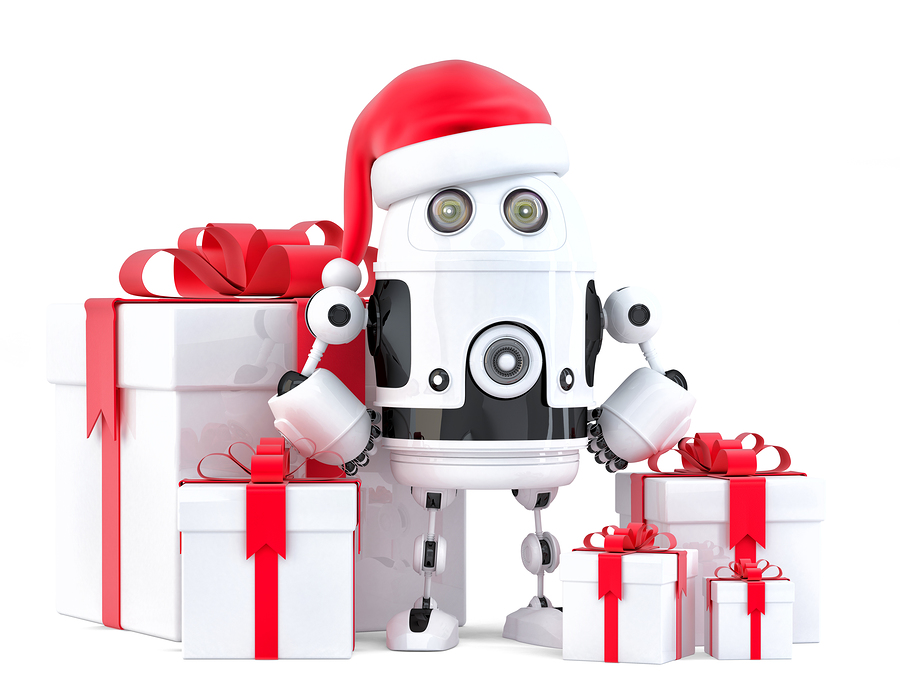
Thanks to all those that sent us their holiday videos. It’s been a tough year for everyone. We hope these videos make these holidays a bit more special.
Did we miss your video? You can send it to daniel.carrillozapata@robohub.org and we’ll include it in this list.
We wish you the very best for these holidays and the year 2021!
How Transformers work in deep learning and NLP: an intuitive introduction
Readers Choice 2020: How Robots Are Changing On-Site Construction
Embracing automation and robots in industry
Carlotta Berry’s talk – Robotics Education to Robotics Research (with video)

A few days ago, Robotics Today hosted an online seminar with Professor Carlotta Berry from the Rose-Hulman Institute of Technology. In her talk, Carlotta presented the multidisciplinary benefits of robotics in engineering education. In is worth highlighting that Carlotta Berry is one of the 30 women in robotics you need to know about in 2020.
Abstract
This presentation summarizes the multidisciplinary benefits of robotics in engineering education. I will describe how it is used at a primarily undergraduate institution to encourage robotics education and research. There will be a review of how robotics is used in several courses to illustrate engineering design concepts as well as controls, artificial intelligence, human-robot interaction, and software development. This will be a multimedia presentation of student projects in freshman design, mobile robotics, independent research and graduate theses.
Biography
Carlotta A. Berry is a Professor in the Department of Electrical and Computer Engineering at Rose-Hulman Institute of Technology. She has a bachelor’s degree in mathematics from Spelman College, bachelor’s degree in electrical engineering from Georgia Institute of Technology, master’s in electrical engineering from Wayne State University, and PhD from Vanderbilt University. She is one of a team of faculty in ECE, ME and CSSE at Rose-Hulman to create and direct the first multidisciplinary minor in robotics. She is the Co-Director of the NSF S-STEM Rose Building Undergraduate Diversity (ROSE-BUD) Program and advisor for the National Society of Black Engineers. She was previously the President of the Technical Editor Board for the ASEE Computers in Education Journal. Dr. Berry has been selected as one of 30 Women in Robotics You Need to Know About 2020 by robohub.org, Reinvented Magazine Interview of the Year Award on Purpose and Passion, Women and Hi Tech Leading Light Award You Inspire Me and Insight Into Diversity Inspiring Women in STEM. She has taught undergraduate courses in Human-Robot Interaction, Mobile Robotics, circuits, controls, signals and system, freshman and senior design. Her research interests are in robotics education, interface design, human-robot interaction, and increasing underrepresented populations in STEM fields. She has a special passion for diversifying the engineering profession by encouraging more women and underrepresented minorities to pursue undergraduate and graduate degrees. She feels that the profession should reflect the world that we live in in order to solve the unique problems that we face.
You can also view past seminars on the Robotics Today YouTube Channel.
Carlotta Berry’s talk – Robotics Education to Robotics Research (with video)

A few days ago, Robotics Today hosted an online seminar with Professor Carlotta Berry from the Rose-Hulman Institute of Technology. In her talk, Carlotta presented the multidisciplinary benefits of robotics in engineering education. In is worth highlighting that Carlotta Berry is one of the 30 women in robotics you need to know about in 2020.
Abstract
This presentation summarizes the multidisciplinary benefits of robotics in engineering education. I will describe how it is used at a primarily undergraduate institution to encourage robotics education and research. There will be a review of how robotics is used in several courses to illustrate engineering design concepts as well as controls, artificial intelligence, human-robot interaction, and software development. This will be a multimedia presentation of student projects in freshman design, mobile robotics, independent research and graduate theses.
Biography
Carlotta A. Berry is a Professor in the Department of Electrical and Computer Engineering at Rose-Hulman Institute of Technology. She has a bachelor’s degree in mathematics from Spelman College, bachelor’s degree in electrical engineering from Georgia Institute of Technology, master’s in electrical engineering from Wayne State University, and PhD from Vanderbilt University. She is one of a team of faculty in ECE, ME and CSSE at Rose-Hulman to create and direct the first multidisciplinary minor in robotics. She is the Co-Director of the NSF S-STEM Rose Building Undergraduate Diversity (ROSE-BUD) Program and advisor for the National Society of Black Engineers. She was previously the President of the Technical Editor Board for the ASEE Computers in Education Journal. Dr. Berry has been selected as one of 30 Women in Robotics You Need to Know About 2020 by robohub.org, Reinvented Magazine Interview of the Year Award on Purpose and Passion, Women and Hi Tech Leading Light Award You Inspire Me and Insight Into Diversity Inspiring Women in STEM. She has taught undergraduate courses in Human-Robot Interaction, Mobile Robotics, circuits, controls, signals and system, freshman and senior design. Her research interests are in robotics education, interface design, human-robot interaction, and increasing underrepresented populations in STEM fields. She has a special passion for diversifying the engineering profession by encouraging more women and underrepresented minorities to pursue undergraduate and graduate degrees. She feels that the profession should reflect the world that we live in in order to solve the unique problems that we face.
You can also view past seminars on the Robotics Today YouTube Channel.
Readers Choice 2020: Using Mesh Network Applications for Robotics
Women in Robotics Update: Ruzena Bajcsy and Radhika Nagpal
Introducing the sixth post in our new series of Women in Robotics Updates, featuring Ruzena Bajcsy and Radhika Nagpal from our first “25 women in robotics you need to know about” list in 2013 and 2014. These women have pioneered foundational research in robotics, created organizations of impact, and inspired the next generations of robotics researchers, of all ages.
“Being an engineer at heart, I really always looked at how technology can help people? That was my model with robots, and in fact, my research in the medical area as well as how can we make things not just empirical, but predictable, ” says Ruzena Bajcsy, expressing the motivation that guides her in both medicine and robotics.
 |
Ruzena Bajcsy
NEC Chair and Professor at University of California Berkeley | Founder of HART
Ruzena Bajcsy (featured 2014) is a National Executive Committee (NEC) Chair and Professor, Department of Electrical Engineering and Computer Science, College of Engineering at University of California, Berkeley. She has been a pioneer in the field since 1988 when she laid out the engineering agenda for active perception. Bajcsy works on modeling people using robotic technology and is inspired by recent animal behavioral studies, especially as they pertain to navigation, namely measuring and extracting non-invasively kinematic and dynamic parameters of the individual to assess their physical movement capabilities or limitations and their respective solutions. Professor Ruzena Bajcsy became the founder of many famous research laboratories, such as, for example, the GRASP laboratory at the University of Pennsylvania, CITRIS Institute and currently the HART (Human-Assistive Robotic Technologies) laboratory. Bajcsy has accomplished and received many prestigious awards in her 60 years in Robotics. Since, last featured she has received the Simon Ramo Founders Award Recipient in 2016, for her seminal contributions to the fields of computer vision, robotics, and medical imaging, and technology and policy leadership in computer science education and research. She also received the 2020 NCWIT Pioneer in Tech Award which is awarded to the role models whose legacies continue to inspire generations of young women to pursue computing and make history in their own right. Throughout her career she has been at the intersection of human and machine ways of interpreting the world, with research interests that include Artificial Intelligence; Biosystems and Computational Biology; Control, Intelligent Systems, and Robotics; Human-Computer Interaction; and “Bridging Information Technology to Humanities and Social Sciences.” In her recent interview at the National Center of Women & Information Technology (NCWIT) to the women who are starting in robotics and AI, she says, ” I have a few rules in my book, so to speak. First of all, when you are young, learn as much mathematics and physics as you can. It is never enough of that knowledge..Number two, you have to be realistic. What, with the current technology, can you verify? Because in engineering science it’s not just writing equations, but it’s also building systems where you can validate your results.” |
 |
Radhika Nagpal
Fred Kavli Professor at Harvard | Cofounder of Root Robotics
Radhika Nagpal (featured in 2013) is a Fred Kavli Professor of Computer Science at the Harvard School of Engineering and Applied Sciences. At her Self-Organizing Systems Research Group she works on Biologically-inspired Robot Collectives, including novel hardware design, decentralized collective algorithms and theory, and global-to-local swarm programming and Biological Collectives, including mathematical models and field experiments with social insects and cellular morphogenesis. Her lab’s Kilobots are licensed and sold by KTeam inc and over 8000 robots exist in dozens of research labs worldwide. Nagpal has won numerous prestigious awards since 2013. She was distinguished as the top ten scientists and engineers who mattered by Nature 10 in 2014. For her excellent empowerment and contribution to next-generation, she received the McDonald Award for Excellence in Mentoring and Advising at Harvard in 2015. She was named an AAAI fellow & Amazon Scholar in 2020. “Science is of course itself an incredible manifestation of collective intelligence, but unlike the beautiful fish school that I study, I feel we still have a much longer evolutionary path to walk..There’s this saying that I love: Who does science determines what science gets done I believe that we can choose our rules and we can engineer not just robots but we can engineer our own human collective and if we do and when we do, it will be beautiful.”, says Nagpal in her Ted Talk “Harnessing the intelligence of the collective” from 2017 which has more than 1 million views. Nagpal is also a co-founder and scientific advisor of Root Robotics which has been acquired by iRobot. Here, she and her team designed Root, an educational robot that drives on whiteboards with magnet+wheels, senses colors, and draws under program control which can be used to teach programming across all ages. With Root, she aims to transform the home and classroom experiences with programming, by making it tangible and personal. “Every kid should learn to code in a fun way, that enhances their interests, and that inspires them to become creative technologies themselves,” says Nagpal. |
Want to keep reading? There are 180 more stories on our 2013 to 2020 lists. Why not nominate someone for inclusion next year!
And we encourage #womeninrobotics and women who’d like to work in robotics to join our professional network at http://womeninrobotics.org
Who are the Visionary companies in robotics? See the 2020 SVR Industry Award winners
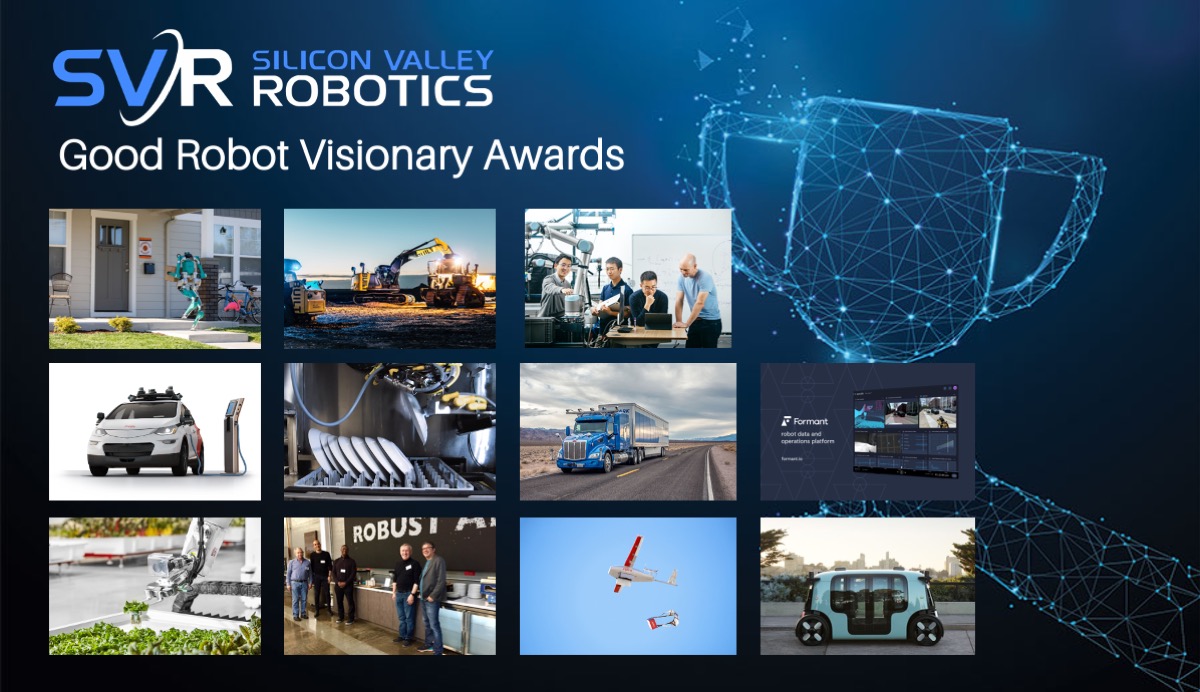 These Visionary companies have a big idea and are well on their way to achieving it, although it isn’t always an easy road for any really innovative technology. In the case of Cruise, that meant testing self driving vehicles on the streets of San Francisco, one of the hardest driving environments in the world. Some of our Visionary Awards go to companies who are opening up new market applications for robotics, such as Built Robotics in construction, Dishcraft in food services, Embark in self-driving trucks, Iron Ox in urban agriculture and Zipline in drone delivery. Some are building tools or platforms that the entire robotics industry can benefit from, such as Agility Robotics, Covariant, Formant, RobustAI and Zoox. The companies in our Good Robot Awards also show that ‘technologies built for us, have to be built by us’.
These Visionary companies have a big idea and are well on their way to achieving it, although it isn’t always an easy road for any really innovative technology. In the case of Cruise, that meant testing self driving vehicles on the streets of San Francisco, one of the hardest driving environments in the world. Some of our Visionary Awards go to companies who are opening up new market applications for robotics, such as Built Robotics in construction, Dishcraft in food services, Embark in self-driving trucks, Iron Ox in urban agriculture and Zipline in drone delivery. Some are building tools or platforms that the entire robotics industry can benefit from, such as Agility Robotics, Covariant, Formant, RobustAI and Zoox. The companies in our Good Robot Awards also show that ‘technologies built for us, have to be built by us’.

Agility Robotics builds robots that go where people go, to do pragmatically useful work in human environments. Digit, Agility Robotics’ humanoid robot with both mobility and manipulation capabilities, is commercially available and has been shipping to customers since July 2020. Digit builds on two decades of research and development from the team on human-like dynamic mobility and manipulation, and can handle unstructured indoor and outdoor terrain. Digit is versatile and can do a range of different jobs that have been designed around a human form factor.
In October 2020, Agility Robotics closed a $20 million Series A round led by DCVC and Playground Global, bringing their total funds raised to $29 million. The investment enables the company to meet the demand from logistics providers, e-commerce retailers and others for robots that can work alongside humans to automate repetitive, physically demanding or dangerous work safely and scalably, even in the majority of spaces that are not purpose-built for automation.
 Built Robotics transforms heavy equipment for the $1 trillion earthmoving industry into autonomous robots using its proprietary AI Guidance Systems. Built Robotics combines sensors such as GPS, cameras, and IMUs with advanced software, and the systems can be installed on standard equipment from any manufacturer. The technology allows equipment operators to oversee a fleet of vehicles working autonomously in parallel.
Built Robotics transforms heavy equipment for the $1 trillion earthmoving industry into autonomous robots using its proprietary AI Guidance Systems. Built Robotics combines sensors such as GPS, cameras, and IMUs with advanced software, and the systems can be installed on standard equipment from any manufacturer. The technology allows equipment operators to oversee a fleet of vehicles working autonomously in parallel.
Built Robotics is backed by some of the top investors in Silicon Valley — including Founders Fund, NEA, and Next47 — and has raised over $48M to date. They have targeted markets in which they can have a big impact, such as earthmoving, clean energy, gas pipelines, trenching, and new housing developments. Built Robotics has partnered with one of the largest labor unions in North America, the IUOE, to help train and develop the next generation of equipment operator.
“At the end of the day, robots are just tools in the hands of skilled operators, and we believe that the best-trained workers equipped with our technology will fundamentally change the future of construction,” said Noah Ready-Campbell, CEO of Built Robotics. “Together we can build and maintain the critical infrastructure our country needs.”

Covariant is building the Covariant Brain, a universal AI to give robots the ability to see, reason and act on the world around them. Bringing practical AI Robotics into the physical world is hard. It involves giving robots a level of autonomy that requires breakthroughs in AI research. That’s why Covariant assembled a team that has published cutting-edge research papers at the top AI conferences and journals, with more than 50,000 collective citations. In addition to their research, they’ve also brought together a world-class engineering team to create new types of highly robust, reliable and performant cyber-physical systems.

Instead of learning to master specific tasks separately, Covariant robots learn general abilities such as robust 3D perception, physical affordances of objects, few-shot learning and real-time motion planning. This allows them to adapt to new tasks just like people do — by breaking down complex tasks into simple steps and applying general skills to complete them. In 2020, Covariant raised a $40 million Series B round from investors such as Index Ventures, Lux Capital and Baidu Ventures, bringing their total funding to $67 million. They’ve also developed partnerships with logistics and robotics companies such as Knapp Ag. and ABB, showcasing successful order pick rates at faster than human speeds.
 Self driving technology, the integration of robotics, AI and simulation, is the hardest engineering challenge of our generation. So it’s only fitting that Cruise autonomous vehicles are on the road in San Francisco navigating some of the most challenging and unpredictable driving environments, because the best way to bring self-driving technology to the world is to expose it to the same unique and complex traffic scenarios human drivers face every day.
Self driving technology, the integration of robotics, AI and simulation, is the hardest engineering challenge of our generation. So it’s only fitting that Cruise autonomous vehicles are on the road in San Francisco navigating some of the most challenging and unpredictable driving environments, because the best way to bring self-driving technology to the world is to expose it to the same unique and complex traffic scenarios human drivers face every day.
Cruise became the industry’s first unicorn when GM acquired the company in 2016. Cruise is building the world’s most advanced all-electric, self-driving vehicles to safely connect people with the places, things, and experiences they care about. And in the first three months of the COVID-19 pandemic, Cruise delivered more than 125,000 contactless deliveries of groceries and meals to San Francisco’s most vulnerable underserved populations. And as of December 4, Cruise has started driverless testing in San Francisco. You can see the video here:


Dishcraft’s mission is to create happy, productive, sustainable workplaces by making automation accessible to food service operations. Dishcraft Daily® delivers a full-service clean-dish ‘dishwashing as a service’ every day to dining operations in business, education, and healthcare, providing measurable environmental benefits compared to using disposable wares.
Dishcraft provides environmental and financial efficiencies for both dine-in and to-go businesses once you calculate the hidden costs of normal restaurant or food service operation. Dishcraft has raised over $25 million from investors including Baseline Ventures, First Round Capital, and Lemnos. The company’s dishwashing as a service is now being used by dozens of companies, including hospitals, around the Bay Area. Since the advent of COVID-19, there’s been an increased demand for food safe and sterile processes in the food service industry.

Embark technology is already moving freight for five Fortune 500 companies in the southwest U.S. By moving real freight through our purpose-built transfer hubs, we are setting a new standard for how driverless trucks will move freight in the future. Embark has compiled many firsts for automated trucks, including driving across the country, operating in rain and fog, and navigating between transfer hubs. Embark is advancing the state of the art in automated trucks and bringing safe, efficient commercial transport closer every day.
Started as University of Waterloo startup, then at YCombinator, Embark has raised more than $117 million with top investors like DCVC and Sequoia Capital. Embark is assembling a world-class group of engineers from companies like Tesla, Google, Audi and NASA with a professional operations team that averages over a million miles per driver, with the goal of developing a system tailored to the demands of real world trucking.

Autonomous robots are awesome, but if you want to run a business with them, you’ll need a robust operations platform that connects people, processes, sensors and robots, and provides fleet-wide management, control, and analytics at scale. That is where Formant comes in.
Formant bridges the gap between autonomous systems and the people running them. Our robot data and operations platform provides organizations with a command center that can be used to operate, observe, and analyze the performance of a growing fleet of heterogeneous robots. Empowering customers to deploy faster, scale while reducing overhead, and maximize the value of autonomous robots and the data they collect.
So far in 2020, Formant’s robot data and operations platform is supporting dozens of different customers with a multitude of robot types and is deployed on thousands of autonomous devices worldwide. Formant’s customers span robot manufacturers, robot-as-a-service providers, and enterprises with robotic installations and represent a variety of industries, from energy to agriculture to warehouse automation.
 Iron Ox is an operator of autonomous robotic greenhouses used to grow fresh and pesticide-free farm products that are accessible everywhere. It leverages plant science, machine learning, and robotics to increase the availability, quality, and flavor of leafy greens and culinary herbs that enable consumers to access naturally grown and chemical-free farm products.
Iron Ox is an operator of autonomous robotic greenhouses used to grow fresh and pesticide-free farm products that are accessible everywhere. It leverages plant science, machine learning, and robotics to increase the availability, quality, and flavor of leafy greens and culinary herbs that enable consumers to access naturally grown and chemical-free farm products.
Iron Ox is reimagining the modern farm, utilizing robotics and AI to grow fresh, consistent, and responsibly farmed produce for everyone. From the development of multiple robot platforms to their own custom hydroponic, seeding, and harvesting systems, Iron Ox is taking a system-level approach to creating the ideal farm. The company’s experienced team of growers, plant scientists, software engineers, and hardware engineers are passionate about bringing forward this new wave of technology to grow local, affordable fresh produce.

Robust.AI is building the world’s first industrial grade cognitive engine, with a stellar team that’s attracted $22.5 million in seed and Series A funding from Jazz Ventures, Playground Global, Fontinalis, Liquid 2, Mark Leslie and Jaan Tallis. Robust’s stated mission is to overhaul the software stack that runs many of existing robots, in order to make them function better in complex environments and be safer for operation around humans.
The all-star team of founders are Gary Marcus and Rodney Brooks, both pioneers in AI and robotics, Mohamed Amer from SRI International, Anthony Jules from Formant and Redwood Robotics, and Henrik Christensen author of the US National Robotics Roadmaps.
“Finding market fit is as important in robots and AI systems as any other product,” Brooks said in a statement. “We are building something we believe most robotics companies will find irresistible, taking solutions from single-purpose tools that today function in defined environments, to highly useful systems that can work within our world and all its intricacies.”
 Zipline is a California-based automated logistics company that designs, manufactures, and operates drones to deliver vital medical products. Zipline’s mission is to provide every human on Earth with instant access to vital medical supplies. In 2014, Zipline started flying medical supplies in Africa, and has gone on to fly more than 39,000 deliveries worldwide and raise over $233 million in funding.
Zipline is a California-based automated logistics company that designs, manufactures, and operates drones to deliver vital medical products. Zipline’s mission is to provide every human on Earth with instant access to vital medical supplies. In 2014, Zipline started flying medical supplies in Africa, and has gone on to fly more than 39,000 deliveries worldwide and raise over $233 million in funding.
Zipline has built the world’s fastest and most reliable delivery drone, the world’s largest autonomous logistics network, and a truly amazing team. Zipline designs and tests its technology in Half Moon Bay, California. The company assembles the drones and the technology that powers its distribution centers in South San Francisco. Zipline performs extensive flight testing in Davis, California, and operates distribution centers around the planet with teams of local operators.

Zoox is working on the full stack for Robo-taxis, providing mobility-as-a-service. Operating at the intersection of design, computer science, and electro-mechanical engineering, Zoox is a multidisciplinary team working to imagine and build an advanced mobility experience that will support the future needs of urban mobility for both people and the environment.

In December 2018, Zoox became the first company to gain approval for providing self-driving transport services to the public in California. In January 2019, Zoox appointed a new CEO, Aicha Evans, who was previously the Chief Strategy Officer at Intel and became the first African-American CEO of a $1B company. Zoox had raised a total of $1B in funding over 6 rounds and on June 26, 2020, Amazon and Zoox signed a “definitive merger agreement” under which Amazon will acquire Zoox for over $1.2 billion. Zoox’s ground-up technology, which includes developing zero-emission vehicles built specifically for autonomous use, could be used to augment Amazon’s logistics operations.
You can see the full list of our Good Robot Awards in Innovation, Vision, Commercialization and our Community Champions here at https://svrobo.org/awards and we’ll be sharing articles about each category of award winners throughout the week.
Who are the Visionary companies in robotics? See the 2020 SVR Industry Award winners
 These Visionary companies have a big idea and are well on their way to achieving it, although it isn’t always an easy road for any really innovative technology. In the case of Cruise, that meant testing self driving vehicles on the streets of San Francisco, one of the hardest driving environments in the world. Some of our Visionary Awards go to companies who are opening up new market applications for robotics, such as Built Robotics in construction, Dishcraft in food services, Embark in self-driving trucks, Iron Ox in urban agriculture and Zipline in drone delivery. Some are building tools or platforms that the entire robotics industry can benefit from, such as Agility Robotics, Covariant, Formant, RobustAI and Zoox. The companies in our Good Robot Awards also show that ‘technologies built for us, have to be built by us’.
These Visionary companies have a big idea and are well on their way to achieving it, although it isn’t always an easy road for any really innovative technology. In the case of Cruise, that meant testing self driving vehicles on the streets of San Francisco, one of the hardest driving environments in the world. Some of our Visionary Awards go to companies who are opening up new market applications for robotics, such as Built Robotics in construction, Dishcraft in food services, Embark in self-driving trucks, Iron Ox in urban agriculture and Zipline in drone delivery. Some are building tools or platforms that the entire robotics industry can benefit from, such as Agility Robotics, Covariant, Formant, RobustAI and Zoox. The companies in our Good Robot Awards also show that ‘technologies built for us, have to be built by us’.

Agility Robotics builds robots that go where people go, to do pragmatically useful work in human environments. Digit, Agility Robotics’ humanoid robot with both mobility and manipulation capabilities, is commercially available and has been shipping to customers since July 2020. Digit builds on two decades of research and development from the team on human-like dynamic mobility and manipulation, and can handle unstructured indoor and outdoor terrain. Digit is versatile and can do a range of different jobs that have been designed around a human form factor.
In October 2020, Agility Robotics closed a $20 million Series A round led by DCVC and Playground Global, bringing their total funds raised to $29 million. The investment enables the company to meet the demand from logistics providers, e-commerce retailers and others for robots that can work alongside humans to automate repetitive, physically demanding or dangerous work safely and scalably, even in the majority of spaces that are not purpose-built for automation.
 Built Robotics transforms heavy equipment for the $1 trillion earthmoving industry into autonomous robots using its proprietary AI Guidance Systems. Built Robotics combines sensors such as GPS, cameras, and IMUs with advanced software, and the systems can be installed on standard equipment from any manufacturer. The technology allows equipment operators to oversee a fleet of vehicles working autonomously in parallel.
Built Robotics transforms heavy equipment for the $1 trillion earthmoving industry into autonomous robots using its proprietary AI Guidance Systems. Built Robotics combines sensors such as GPS, cameras, and IMUs with advanced software, and the systems can be installed on standard equipment from any manufacturer. The technology allows equipment operators to oversee a fleet of vehicles working autonomously in parallel.
Built Robotics is backed by some of the top investors in Silicon Valley — including Founders Fund, NEA, and Next47 — and has raised over $48M to date. They have targeted markets in which they can have a big impact, such as earthmoving, clean energy, gas pipelines, trenching, and new housing developments. Built Robotics has partnered with one of the largest labor unions in North America, the IUOE, to help train and develop the next generation of equipment operator.
“At the end of the day, robots are just tools in the hands of skilled operators, and we believe that the best-trained workers equipped with our technology will fundamentally change the future of construction,” said Noah Ready-Campbell, CEO of Built Robotics. “Together we can build and maintain the critical infrastructure our country needs.”

Covariant is building the Covariant Brain, a universal AI to give robots the ability to see, reason and act on the world around them. Bringing practical AI Robotics into the physical world is hard. It involves giving robots a level of autonomy that requires breakthroughs in AI research. That’s why Covariant assembled a team that has published cutting-edge research papers at the top AI conferences and journals, with more than 50,000 collective citations. In addition to their research, they’ve also brought together a world-class engineering team to create new types of highly robust, reliable and performant cyber-physical systems.

Instead of learning to master specific tasks separately, Covariant robots learn general abilities such as robust 3D perception, physical affordances of objects, few-shot learning and real-time motion planning. This allows them to adapt to new tasks just like people do — by breaking down complex tasks into simple steps and applying general skills to complete them. In 2020, Covariant raised a $40 million Series B round from investors such as Index Ventures, Lux Capital and Baidu Ventures, bringing their total funding to $67 million. They’ve also developed partnerships with logistics and robotics companies such as Knapp Ag. and ABB, showcasing successful order pick rates at faster than human speeds.
 Self driving technology, the integration of robotics, AI and simulation, is the hardest engineering challenge of our generation. So it’s only fitting that Cruise autonomous vehicles are on the road in San Francisco navigating some of the most challenging and unpredictable driving environments, because the best way to bring self-driving technology to the world is to expose it to the same unique and complex traffic scenarios human drivers face every day.
Self driving technology, the integration of robotics, AI and simulation, is the hardest engineering challenge of our generation. So it’s only fitting that Cruise autonomous vehicles are on the road in San Francisco navigating some of the most challenging and unpredictable driving environments, because the best way to bring self-driving technology to the world is to expose it to the same unique and complex traffic scenarios human drivers face every day.
Cruise became the industry’s first unicorn when GM acquired the company in 2016. Cruise is building the world’s most advanced all-electric, self-driving vehicles to safely connect people with the places, things, and experiences they care about. And in the first three months of the COVID-19 pandemic, Cruise delivered more than 125,000 contactless deliveries of groceries and meals to San Francisco’s most vulnerable underserved populations. And as of December 4, Cruise has started driverless testing in San Francisco. You can see the video here:


Dishcraft’s mission is to create happy, productive, sustainable workplaces by making automation accessible to food service operations. Dishcraft Daily® delivers a full-service clean-dish ‘dishwashing as a service’ every day to dining operations in business, education, and healthcare, providing measurable environmental benefits compared to using disposable wares.
Dishcraft provides environmental and financial efficiencies for both dine-in and to-go businesses once you calculate the hidden costs of normal restaurant or food service operation. Dishcraft has raised over $25 million from investors including Baseline Ventures, First Round Capital, and Lemnos. The company’s dishwashing as a service is now being used by dozens of companies, including hospitals, around the Bay Area. Since the advent of COVID-19, there’s been an increased demand for food safe and sterile processes in the food service industry.

Embark technology is already moving freight for five Fortune 500 companies in the southwest U.S. By moving real freight through our purpose-built transfer hubs, we are setting a new standard for how driverless trucks will move freight in the future. Embark has compiled many firsts for automated trucks, including driving across the country, operating in rain and fog, and navigating between transfer hubs. Embark is advancing the state of the art in automated trucks and bringing safe, efficient commercial transport closer every day.
Started as University of Waterloo startup, then at YCombinator, Embark has raised more than $117 million with top investors like DCVC and Sequoia Capital. Embark is assembling a world-class group of engineers from companies like Tesla, Google, Audi and NASA with a professional operations team that averages over a million miles per driver, with the goal of developing a system tailored to the demands of real world trucking.

Autonomous robots are awesome, but if you want to run a business with them, you’ll need a robust operations platform that connects people, processes, sensors and robots, and provides fleet-wide management, control, and analytics at scale. That is where Formant comes in.
Formant bridges the gap between autonomous systems and the people running them. Our robot data and operations platform provides organizations with a command center that can be used to operate, observe, and analyze the performance of a growing fleet of heterogeneous robots. Empowering customers to deploy faster, scale while reducing overhead, and maximize the value of autonomous robots and the data they collect.
So far in 2020, Formant’s robot data and operations platform is supporting dozens of different customers with a multitude of robot types and is deployed on thousands of autonomous devices worldwide. Formant’s customers span robot manufacturers, robot-as-a-service providers, and enterprises with robotic installations and represent a variety of industries, from energy to agriculture to warehouse automation.
 Iron Ox is an operator of autonomous robotic greenhouses used to grow fresh and pesticide-free farm products that are accessible everywhere. It leverages plant science, machine learning, and robotics to increase the availability, quality, and flavor of leafy greens and culinary herbs that enable consumers to access naturally grown and chemical-free farm products.
Iron Ox is an operator of autonomous robotic greenhouses used to grow fresh and pesticide-free farm products that are accessible everywhere. It leverages plant science, machine learning, and robotics to increase the availability, quality, and flavor of leafy greens and culinary herbs that enable consumers to access naturally grown and chemical-free farm products.
Iron Ox is reimagining the modern farm, utilizing robotics and AI to grow fresh, consistent, and responsibly farmed produce for everyone. From the development of multiple robot platforms to their own custom hydroponic, seeding, and harvesting systems, Iron Ox is taking a system-level approach to creating the ideal farm. The company’s experienced team of growers, plant scientists, software engineers, and hardware engineers are passionate about bringing forward this new wave of technology to grow local, affordable fresh produce.

Robust.AI is building the world’s first industrial grade cognitive engine, with a stellar team that’s attracted $22.5 million in seed and Series A funding from Jazz Ventures, Playground Global, Fontinalis, Liquid 2, Mark Leslie and Jaan Tallis. Robust’s stated mission is to overhaul the software stack that runs many of existing robots, in order to make them function better in complex environments and be safer for operation around humans.
The all-star team of founders are Gary Marcus and Rodney Brooks, both pioneers in AI and robotics, Mohamed Amer from SRI International, Anthony Jules from Formant and Redwood Robotics, and Henrik Christensen author of the US National Robotics Roadmaps.
“Finding market fit is as important in robots and AI systems as any other product,” Brooks said in a statement. “We are building something we believe most robotics companies will find irresistible, taking solutions from single-purpose tools that today function in defined environments, to highly useful systems that can work within our world and all its intricacies.”
 Zipline is a California-based automated logistics company that designs, manufactures, and operates drones to deliver vital medical products. Zipline’s mission is to provide every human on Earth with instant access to vital medical supplies. In 2014, Zipline started flying medical supplies in Africa, and has gone on to fly more than 39,000 deliveries worldwide and raise over $233 million in funding.
Zipline is a California-based automated logistics company that designs, manufactures, and operates drones to deliver vital medical products. Zipline’s mission is to provide every human on Earth with instant access to vital medical supplies. In 2014, Zipline started flying medical supplies in Africa, and has gone on to fly more than 39,000 deliveries worldwide and raise over $233 million in funding.
Zipline has built the world’s fastest and most reliable delivery drone, the world’s largest autonomous logistics network, and a truly amazing team. Zipline designs and tests its technology in Half Moon Bay, California. The company assembles the drones and the technology that powers its distribution centers in South San Francisco. Zipline performs extensive flight testing in Davis, California, and operates distribution centers around the planet with teams of local operators.

Zoox is working on the full stack for Robo-taxis, providing mobility-as-a-service. Operating at the intersection of design, computer science, and electro-mechanical engineering, Zoox is a multidisciplinary team working to imagine and build an advanced mobility experience that will support the future needs of urban mobility for both people and the environment.

In December 2018, Zoox became the first company to gain approval for providing self-driving transport services to the public in California. In January 2019, Zoox appointed a new CEO, Aicha Evans, who was previously the Chief Strategy Officer at Intel and became the first African-American CEO of a $1B company. Zoox had raised a total of $1B in funding over 6 rounds and on June 26, 2020, Amazon and Zoox signed a “definitive merger agreement” under which Amazon will acquire Zoox for over $1.2 billion. Zoox’s ground-up technology, which includes developing zero-emission vehicles built specifically for autonomous use, could be used to augment Amazon’s logistics operations.
You can see the full list of our Good Robot Awards in Innovation, Vision, Commercialization and our Community Champions here at https://svrobo.org/awards and we’ll be sharing articles about each category of award winners throughout the week.
